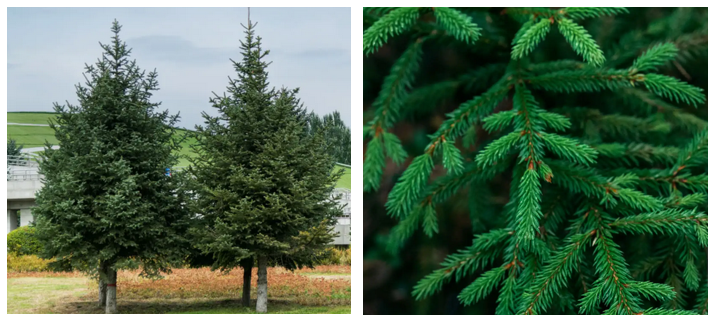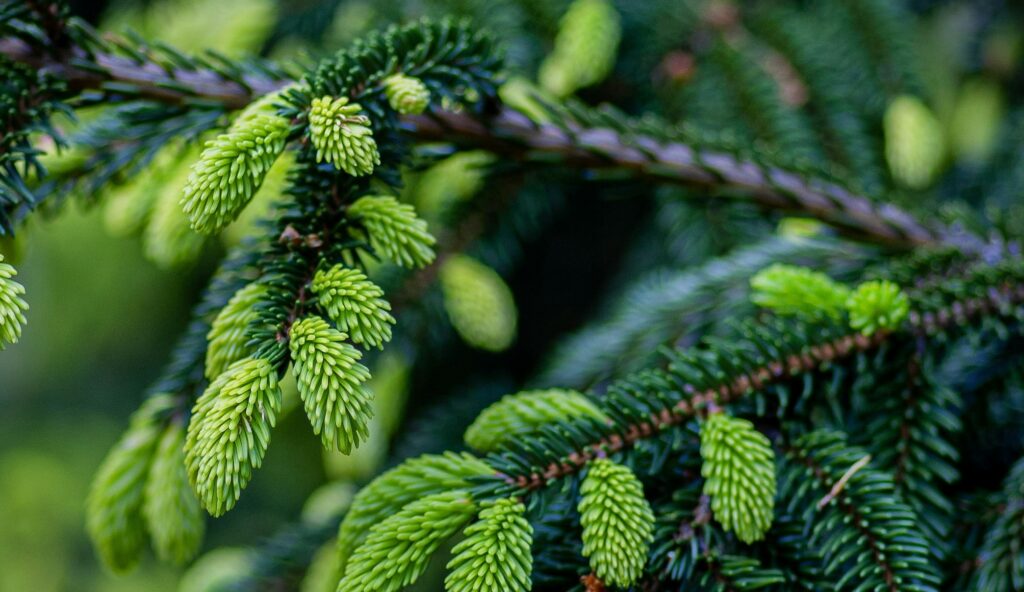Yes, you read that right — spruce tips. They’re easy to identify, easy to pick, and all varieties are edible. Spruce tips can be steamed or sautéed as vegetables, or combined with fish and wild game. They are used in many Canadian and Alaskan beer recipes. They can be chopped and added to cakes, bread, and shortbread. They can also be used to make teas, syrups, and my personal favorite, jelly.
Identification
Spruce trees are evergreens, meaning that they stay green all year, and also conifers, meaning that they bear cones. There are about 40 species of spruce trees worldwide, all of which grow in the northern latitudes. There are seven varieties native to the U.S.: red, black, and white spruces are the only species native in the eastern part of the country. Spruces have a narrow conical shape overall, and their branches are arranged in a circular pattern. Spruce trees have rough bark, even when young. Like pines and firs, spruce trees have needles rather than leaves. Spruce needles are sharp, stiff, and square, so they can be easily rolled between your fingers.

Spruce trees have two look-alikes, one edible and one extremely toxic. Hemlock evergreens (no relationship to the poisonous hemlock plant) bear small cones, and have needles are 1/4 to 3/4 in length, flat, and rounded at the tip. The underside of the needles are whitish in color, with a green midvein that gives them a striped appearance.
Yews, which are extremely toxic, have flat, sharply pointed needles that grow in two rows. They do not produce cones but instead grow bright red fruits in the fall.

Harvesting
Every spring, the end of almost every branch has a bud-like tip that sheds a papery brown husk and produces a new bunch of needles. Harvested when they first begin to emerge from their casings, spruce tips are very tender and soft. Don’t denude the tree of it’s tips, or there will be no new growth!

Preparing
Like everything else from the wild, wash them thoroughly as soon as you get home, making sure to remove any casing bits. The clean tips can sit happily in an airtight container in your fridge for a few days, but don’t store them so long that they start turning grey. I’ve had inconsistent luck freezing spruce tips for later use; sometimes they’ve done just fine, sometimes they’ve come out of the freezer a sickly brownish color. I think the trick may be to freeze them immediately after harvesting, chopped or whole. Experiment and see what works for you, and if you figure it out, let me know. When using tips as a vegetable, keep them whole. For baking, tea, and jelly making, chop the tips up finely before measuring the amount needed.
Jelly
Spruce tip jelly has a light, bright citrus flavor with a hint of pine, and is absolutely excellent with peanut butter. I’ve given the recipe for spruce tip jelly in another blog post, but here it is again: Make an infusion of 4 cups of chopped spruce tips and 4 cups of boiling water. Let it sit for 24 hours, then strain out the tips. Use 4 cups of infusion, 2 cups of sugar, and 1/3 cup of low-sugar pectin to make the jelly.
Happy foraging!



